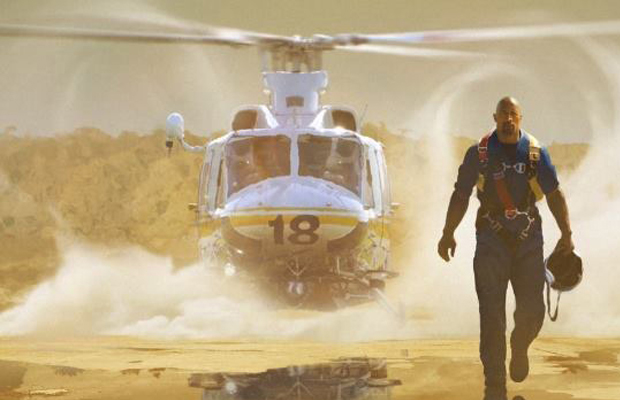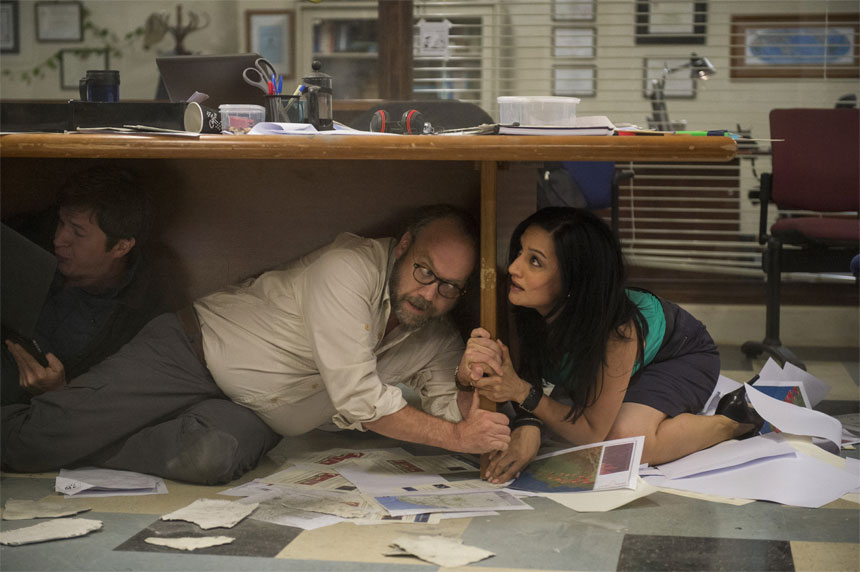Reviewed by GREG KING
Director: Brad Peyton
Stars: Dwayne Johnson, Carla Gugino, Alexandra Daddario, Paul Giamatti, Ioan Gruffudd, Archie Panjabi, Colton Haynes, Hugo Johnstone-Burt, Art Parkinson,Kylie Minogue, Will Yun Lee, Matt Gerald, Alec Utgoff.

In the 70s the disaster film was quite a popular genre, with producer Irwin Allen establishing the template with films such as Earthquake, The Towering Inferno, The Poseidon Adventure. Along with films like Airport the genre dominated at the box office in the early 70s until a few lesser efforts tanked. These films usually featured star studded casts, with the likes of Charlton Heston, Gene Hackman, Steve McQueen and Paul Newman taking charge of perilous situations. They brought a touch of gravitas to the material.
But those films also spent plenty of time to develop the various characters and create some dynamic tension between characters before the ultimate disaster struck. And there was usually a villain or two as well, either a crooked contractor or a developer who cut corners and wouldn’t listen to reason, who ironically got their comeuppance eventually.
And those films used models and real life stunts to create a sense of drama, as ordinary people used their wits to try and survive. And we cared about most of those characters and their fate.
And way back in 1975 a film like Earthquake used the novelty of Sensurround to immerse audiences in the experience as cinema seats shook and rattled along with the earthquake. Now the producers just use 3D to try an immerse audiences, but it doesn’t quite have the same impact.
Unfortunately now most modern disaster films do not compare favourably with many of those classics of our youth, even though many of them seem a little dated and clunky now. The effects are created digitally and most of the actors perform against a green screen, so the situations do not carry the same sense of danger. We don’t feel any sense of empathy or compassion for the victims. It’s almost as if the writers and directors seem in a hurry to rush to the spectacular effects in the belief that contemporary audiences won’t sit still long for lots of character development and elaborate setups.
And the disasters take on gigantic, almost epic proportions as well. Thus directors like Roland Emmerich give us The Day After Tomorrow or 2012 in which the scale of the disaster swamps effective characterisations and heroic deeds.
The lastest in the disaster film genre is San Andreas and it suffers from a lacklustre script. The script has been written by Carlton Cuse (best known for his work on tv series like Lost, Bates Motel, etc), Andre Fabrizio and Jeremy Passmore (the Red Dawn remake, etc). The set ups here are quite cheesy, and much of the dialogue is so corny and cliched that audiences at the preview burst out laughing during the screening.
Paul Giamatti (slumming it here) plays Lawrence, a seismologist at a Californian University, who is developing techology to predict quakes. His team detect seismic activity in Nevada, a place not known for tectonic plates or earthquakes. And before long, a massive quake erupts, smashing the Hoover Dam and flooding a large area. But there is no gradual buildup to this event – , such as a small trickle from the dam as an early warning of what it to come, no sense of Giamatti warning of the likelihood of this quake, or his warnings falling on deaf ears as bureaucrats do not spring into action.
 And then Giamatti predicts that a massive quake is about to erupt on the famous San Andreas fault, stretching from Los Angeles to San Francisco. And lo and behold, a quake registering 9.6 on the Richter Scale erupts and flattens the two cities. Skyscrapers crumble and collapse onto the streets in a spectacular display of CGI effects, and an enormous tidal wave floods much of San Francisco. The computer generated special effects are certainly stunning, but they are also too familiar as we have seen cities destroyed in a number of recent superhero movies and Michael Bay action movies, so these sequences seem a bit humdrum.
And then Giamatti predicts that a massive quake is about to erupt on the famous San Andreas fault, stretching from Los Angeles to San Francisco. And lo and behold, a quake registering 9.6 on the Richter Scale erupts and flattens the two cities. Skyscrapers crumble and collapse onto the streets in a spectacular display of CGI effects, and an enormous tidal wave floods much of San Francisco. The computer generated special effects are certainly stunning, but they are also too familiar as we have seen cities destroyed in a number of recent superhero movies and Michael Bay action movies, so these sequences seem a bit humdrum.
The human story centres around the character of Ray Gaines (played stoically by Dwayne Johnson), a helicopter pilot with Los Angeles’ Fire Department’s Rescue Unit. He is still troubled by the fact that one of his daughters drowned a couple of years ago during a rafting accident. Now he learns that his oldest daughter Blake (Alexandra Daddario, from the Percy Jackson series, etc) is trapped somewhere in San Francisco, after having been abandoned by her caddish new stepfather (Ioan Gruffudd), a wealthy architect, at the first sign of disaster. Rather than doing his job and rescuing citizens trapped by the quake, Ray and his ex-wife Emma (Carla Gugino) set out to fly to San Francisco in his fire department helicopter and rescue Blake. Not even knowing if she has survived, or how he will find her in the devastated city.
Emma has just served Ray with divorce papers, but there is no hint of resentment or simmering tension between the two as they head off on their journey.
Unfortunately the writers don’t give Johnson much to do. He is the one of the top macho action heroes in movies today, and has a strong physical presence that has been well used to reinvigorate a couple of franchises like GI Joe and Fast And The Furious, but during this journey he doesn’t really get to rescue anyone from danger or flex his muscles. He mainly flies from point A to point B. And he even drives a power boat through a tsunami!
The most involving storyline centres around the plight of his daughter Blake. She has managed to hook up with a couple of British lads – aspiring architect Ben (played by Australian actor Hugo Johnstone Burt, from Home And Away and Miss Fisher’s Murder Mysteries, etc) and his cheeky and inquisitive younger brother Ollie (played by Art Parkinson, from Game Of Thrones, etc) – and they try to make their way across the flattened, burning city to reach high ground and safety.
And our own Kylie Minogue has a blink and you miss her cameo!
The director is Brad Peyton who put Johnson through his paces in Journey 2: The Mysterious Island a couple of years ago. Peyton is certainly a dab hand with special effects and CGI and the film certainly delivers some over the top sequences as buildings collapse and familiar landmarks are destroyed. But there is a distinct lack of originality to San Andreas which becomes bogged down in a succession of cliched set pieces. The film was shot largely at the Gold Coast studios in Australia, but the production team have effectively digitally recreated the streets of San Francisco.
For many, San Andreas will be something of a guilty pleasure!
★★☆



